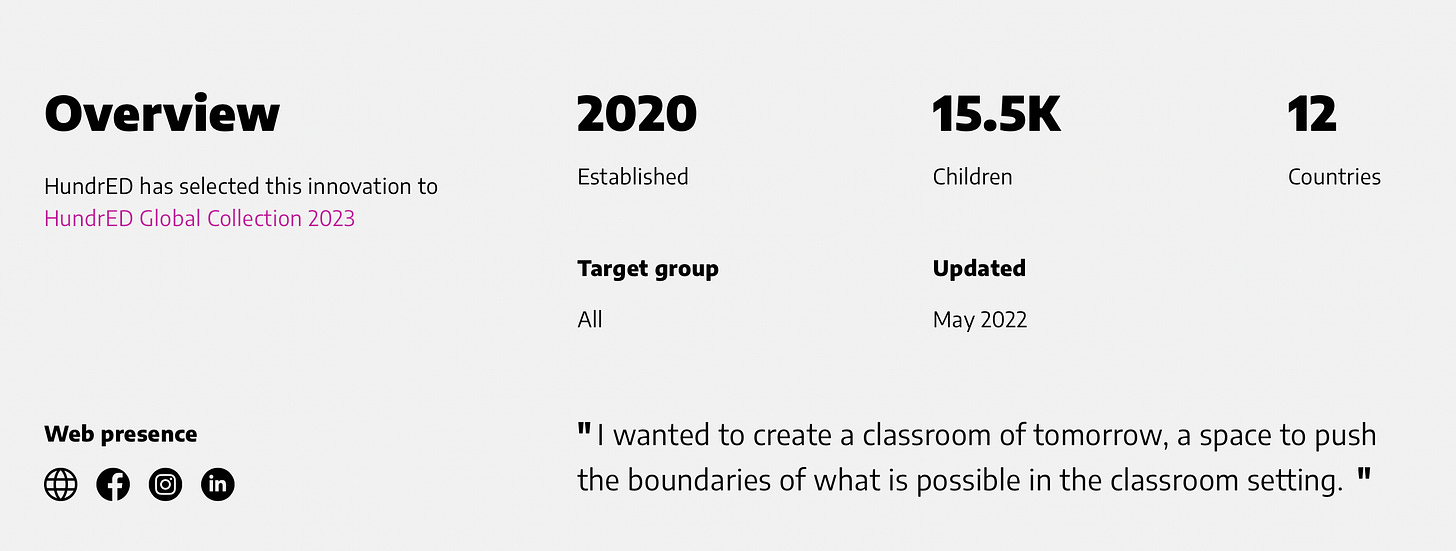As one year draws to a close, it naturally makes us curious about the next. Curiosity, I have learned is a good thing. In one of my favourite TED talks, the late Ken Robinson spoke with passion about how children are born curious but our education systems suck it out of them. This is a truth that knocks me into ruins.
In 2020, in the midst of a global pandemic I created the Future Classroom. It was a thought experiment at the time, or a colleague put it, ‘a welcome disruption.’
3-years on it has become a proof of concept, blueprint for what’s possible and a space that children literally run to get to. Reaching 15.5k children in 12 countries, the Future Classroom now has a twin in Accra, Ghana. So what is it that engages the hearts and minds of children and makes them fall in love with this intriguing classroom?
I feel short description of the Future Classroom from 2021 captures its appeal:
I saw the potential to create a space where knowledge and skills could co-exist, a space where technology supports the teachers and doesn't try to replace them. I have designed a learning environment that is engaging and practical. Through progressive teaching and warm technology, children are encouraged to be brilliant owners of knowledge, not just consumers of it.
(BBC Sounds with Steve Harris, Oct 2021)
I often get asked about impact. It seems even critics are curious. When you build a space that disrupts the established ways of ‘doing education’, you are bound to unsettle a few folks in the process. The magic combination is to combine great teaching with the best available technology, then empower the children to guide the learning. Let’s talk impact for a moment.
The graph below illustrates how the Future Classroom was rated for Impact and Scalability by a team of 40 Hundred.Org Academy experts. You can see the distribution of data in the upper right zone - High Impact: High Scalability. But, what does that mean?
To progress through each phase, all innovations must have shown evidence for impact and scalability by the reviewers using the following definitions:
Impact: Evaluated as a valuable improvement within the innovation’s context. All innovations must have at-least 1-year of being implemented with its intended users.
Scalability: Either the innovation is actively expanding to other contexts or has a high degree of transferability for others to adopt its practice/technology.
Source: Hundred.Org
The diagram below shows the selection process that all innovations go through as they are tested against rigorous metrics.
Source: Hundred.org
Here is what some of the experts said about the Future Classroom project:
This project is already used in 12 countries, and has the potential to grow even further. Technology, for example, is a very relevant part of life, so skills involving it will remain valuable as this innovation expands.
“The Classroom of the Future” is a great innovation that fosters classroom interaction and peer to peer learning. It challenges the students to take charge of their learning whilst allowing the teachers to monitor and correct where possible.
Staying curious
3 years on, the Future Classroom concept has grown beyond my expectations. As the infographic below shows, 15.5k children have been reached globally. That number will be out of date by next week. Interest in the room (and what goes on inside) is enduring. Last week, we hosted 10 teachers from Lithuania who were curious to see lessons and meet the students. Every week we buzz into Ghana live and learn together. 8 podcasts, 22 press releases, 7 blogs and a published journal - all about one room. People are curious and curiosity is what keeps the human fire burning. The best part for me, is kids are still running to get to the Future Classroom. Once inside, they are encouraged to be curious and to engage their hearts and minds. Give children space to learn and grow and you can visibly see them leave a little taller by the end of the lesson.
Next week: Part 2 - Should every school have a future classroom ?
Infographic showing the scale and impact of the Future Classroom from 2020-2023. To read more about Hundred.org or this project, click the link: Curious?







